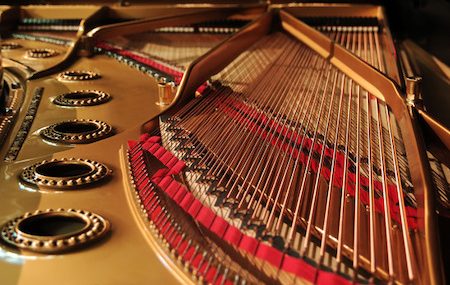When buying a used piano, the most important part is ensuring it’s still a high-quality instrument. While it may look okay on the outside, it takes more than a quick glance to ensure it’s in good shape.
Sometimes what you can’t see can impact the overall playability.
Smoke damage is one of those items you might not notice right away. Smoke is created from incomplete combustion, creating a residue of carbon particles. All smoke is not the same. Cigarette smoke is different from smoke that comes from anything else burning – paper, wood, plastic. It can create complex odors that leave a difficult film that’s hard to get out. Once it settles in, it can cause discoloration, corrosion, lingering odors, and damage the internal workings of the instrument.
Smoke comes in one of two formats: driven or free-floating. Driven smoke is the most powerful, having pressure behind it to push it into all kinds of places. Free-floating smoke is driven smoke that has lost its power. It’s residual smoke that settles onto horizontal platforms as it settles in.
With all types of smoke, driven smoke moves in and finds the small hiding places. It can penetrate the cracks, get underneath the lid of the piano, and move between the keys and strings. Free-floating smoke is what lands on the keyboard and case. Together, they can create a host of odors that fall into one of three categories: synthetic, natural, and protein.
Synthetic odors come from plastics and textiles. This shows as black residue and smudges easily.
Natural odors come from natural materials such as wood or paper products. This creates a gray-black residue with a powdery consistency.
Protein odors often start in the kitchen from meat or grease fires. They produce a yellowish color and require the most intense process to remove the complex odors.
A piano is made from a variety of different materials, including wood, metal, felt, and plastic. If a piano comes into contact with smoke, it can also be subjected to intense heat. Heat impacts the levels of humidity, which can impact the structural integrity of the piano too. As the various materials expand and contract, the smoke moves into various places inside and out of the piano. Different odors can settle into tight places, making them harder to retrieve.
Because much of the piano is porous by nature, it is highly susceptible to odors. Once it gets into the wood, particleboard, felt, and other materials, there is little you can do to remove it.
If your piano has any smoke damage, the best place to start is by working with a piano technician. Have them evaluate the damage, and make a determination on whether it can be fixed.
Have additional questions about smoke damage to your piano? Give us a call today. We can point you in the right direction for bringing music back into your life.


